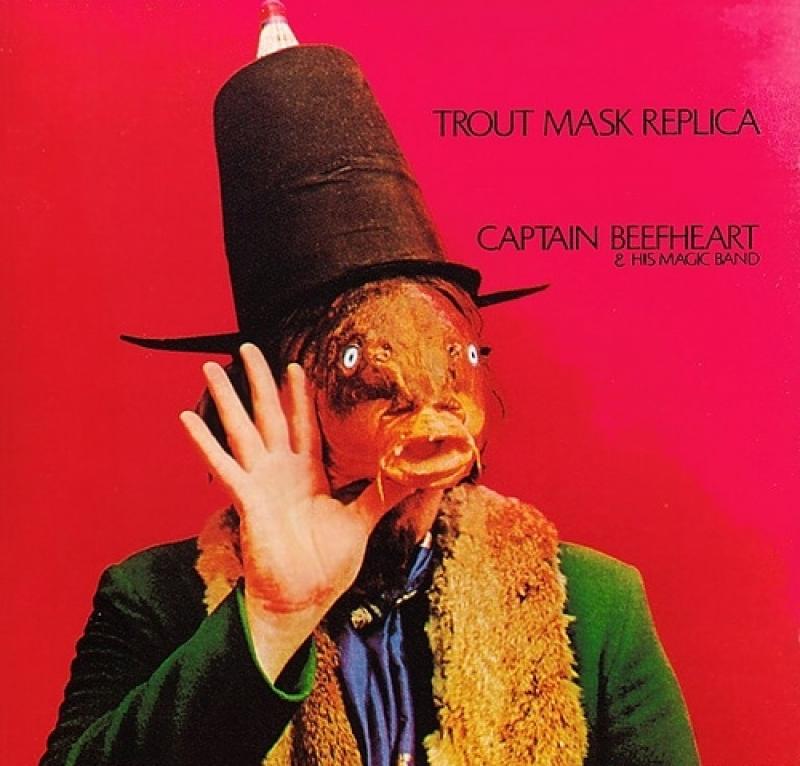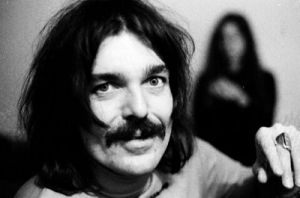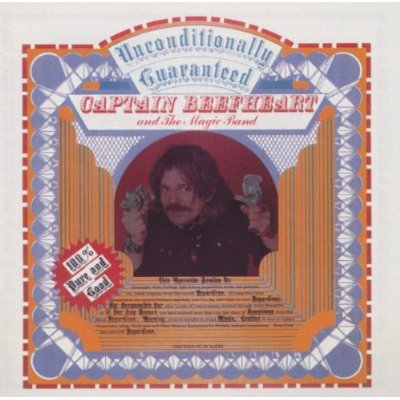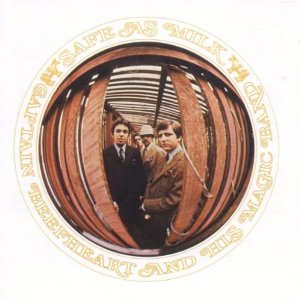Captain Beefheart, 1941-2010 | reviews, news & interviews
Captain Beefheart, 1941-2010
Captain Beefheart, 1941-2010
The Don of Dada is remembered by those who knew him

"The way I keep in touch with the world… is very gingerly… because the world touches too hard." That honest and hugely poignant statement by the musician, composer, songwriter, painter and full-on eccentric Captain Beefheart comes from a documentary film by Anton Corbijn titled Don van Vliet: Some Yo Yo Stuff (1994).
 The film begins with his mother tenderly carrying a cardboard cut-out of a black-and-white photograph of him by his friend Anton. She walked slowly across a patch of the American desert near where Don van Vliet shed his Captain image and lived with his wife Jan, painting and, as he put it, watching the crows. She passed a giant Joshua tree whose prickliness and dominating presence in the hard landscape feels like a symbol of his once bear-like presence. She gently placed the image on the stony ground and facing the camera, told us, “This is my son.” It feels like a ceremony anticipating his death, planting him in the desert where he said many times that he felt safest.
The film begins with his mother tenderly carrying a cardboard cut-out of a black-and-white photograph of him by his friend Anton. She walked slowly across a patch of the American desert near where Don van Vliet shed his Captain image and lived with his wife Jan, painting and, as he put it, watching the crows. She passed a giant Joshua tree whose prickliness and dominating presence in the hard landscape feels like a symbol of his once bear-like presence. She gently placed the image on the stony ground and facing the camera, told us, “This is my son.” It feels like a ceremony anticipating his death, planting him in the desert where he said many times that he felt safest.
While this is the time to contemplate his output and the reason for his extraordinary popularity spanning generations and countries, the only way to do it is to crank up the volume and listen to one of the most important albums in the history of recorded music (as John Peel put it), the astonishingly perfect treasure, Trout Mask Replica, the 1969 album created over a whole year in a house where Beefheart’s eponymous Magic Band transformed the ideas bursting out of their leader's head into playable music. They were drilled solidly in that house, until fingers bled and everything was perfect. It is still way ahead of almost anything produced since in its originality, musically and lyrically, and in many ways is on a par with the similarly multimedia genius Sun Ra, who also dressed in capes and hats and Dada-esque outfits, and was similarly a dictatorial band leader who shared a house with his band.
"Sure 'Nuff 'n Yes I Do": Captain Beefheart live in Cannes, 1968
Beefheart was a beacon of surreal eccentricity, a purveyor of staccato phrases which he partly sang and spoke in a voice beyond description in its tonal range and muddy, gritty textures which could instantly switch to an Otis Redding-like soul singer's. Clumps of word-plays and puns hit the air and were transformed into painted images then solidified into marvellous abstract, grotesque and beautiful virtual sculptures. Art was his first and last love, but only he could exclude music from that statement, and while art book-ended his creative life and fed him when he was incapable of creating it himself any more, the songs form the centre piece to his story.
His influence has been vast and the responses to his death, predictably massive, rolling through continuously to his website. This is no conventional fan club but a vast web of some of the most significant multimedia artists around the globe, including film-maker David Lynch, who conversed with Don across a screen during Corbijn’s film, Tom Waits whose gritty, bear-like voice must surely mean he's the great man’s son, and Johnny Rotten who, I assume, fell for his fearlessness, humour and rich language. And skipping generations, messages have already passed through space from Alex Kapranos representing Franz Ferdinand, the Klaxons and Zutons (an appropriately Beefheartian name), and one of his closest musical relatives, the White Stripes.
 I fell for the Captain’s music, presentation and imagery while working at Virgin Records as press and marketing officer in the mid-Seventies. The day Beefheart walked into the office it couldn’t have been more exciting for all of us than if Dylan or Lennon had dropped by to sign up. Simon Draper, the MD, was in a reserved swoon; he’d listened to expensive imports all through his university years in South Africa. It was the lowest musical point in Beefheart's career, when his Magic Band had finally given up on the stress of his volatile, erratic way of working, and he was releasing two albums. To me, they were magic even though Unconditionally Guaranteed and Blue Jeans and Moonbeams rated way below the calibre of the previous seven which had turned our lives around.
I fell for the Captain’s music, presentation and imagery while working at Virgin Records as press and marketing officer in the mid-Seventies. The day Beefheart walked into the office it couldn’t have been more exciting for all of us than if Dylan or Lennon had dropped by to sign up. Simon Draper, the MD, was in a reserved swoon; he’d listened to expensive imports all through his university years in South Africa. It was the lowest musical point in Beefheart's career, when his Magic Band had finally given up on the stress of his volatile, erratic way of working, and he was releasing two albums. To me, they were magic even though Unconditionally Guaranteed and Blue Jeans and Moonbeams rated way below the calibre of the previous seven which had turned our lives around.
I was curious to hear reflections and memories from the true fans and someone involved with Don, as the Captain was known. Here then are the thoughts from various areas of the music industry. Steve Lewis was a Virgin A&R man who ran Beefheart’s US tours and organised his final two albums for the label. The musical influence of Beefheart is assessed by David Toop, the musician/composer, sound artist and writer who works in the deep avant-garde. Finally, the journalist Greg Neale, who interviewed the Captain several times between the late 1960s and early 1970s.
STEVE LEWIS
I’d driven my friends mad with Trout Mask Replica when I was 16. Then I got a job at Virgin Records and eventually, I worked with Don. He was such an extraordinary man - no, a genius, and an eccentric; a joy to be with. And such a mimic. When he came to the Virgin office off Portobello Road, I took him to lunch locally to a galette place. It was a new experience for him; the menu was in French! He said, "I’ll take the same as you," then added, "This is FANTASTIC! You sure know how to eat and drink." After that first meal, he not only ordered exactly the same as me every time he ate, but would solemnly inform the waiter on each occasion, that he was doing so because "He sure knows how to eat and drink." It was an almost childlike wonderment that I was so certain about what to order and he clearly wasn't.
Listen to "Neon Meate Dream of A Octafish"
Soon after we met, around 1980, we were discussing Neon Meate Dream of A Octafish and I commented on the use of the "A" rather than "An" in the title. Don said it was done intentionally, an error for his amusement. He liked to play with language and he was obviously pleased I noticed it and congratulated me on 'getting it.' I organised the UK tour and boy, did he make those guys work. Gary Lucas, the guitarist, rehearsed until his fingers bled – and was technically brilliant. What I liked was the combination of those surreal lyrics, phrases like "fast and bulbous" which became catchphrases, with that Howlin' Wolf kind of delivery. "I don’t like that rock’n roll heartbeat," he said to me. "Boom – boom – boom; it's like Mama’s heartbeat," (a phrase he often used). My favourite line is “My head is my only home except when it rains”.
One time, he sent me the photo for the sleeve of the album Doc at the Radar Station taken by Michael Kent Rothman. When I received it, I telephoned him to say I liked the shot and in particular the "tie clip." When we subsequently met for dinner in LA, him having driven in from Lancaster (his desert home), he fished the clothes peg out of the car, carefully placed it on his tie, unaware that I was watching from the walkway above the motel carpark, and he told me he was wearing it for me.
DAVID TOOP
When I was an art student in Watford in 1968, we woke up to Captain Beefheart’s first LP, Safe as Milk, every morning in our student house. Then I bought an American import of Trout Mask Replica. That made a huge impression on me, the sense that rock music could be both precise and wild. The more time has gone on, the more precise it seems, partly because we now know how strictly the Magic Band musicians were drilled by him. I like the combination of free jazz and blues, though his imitation of Howlin' Wolf seemed close to rip off at time, and Wolf was so unique that any imitation was always going to sound slightly unconvincing.
I’d grown up with blues and moved into free jazz. Recently, listening to early 1970s recordings of me and Paul Burwell, I can hear some Trout Mask influence on my guitar style - very jerky and fragmented - and (John French) Drumbo’s playing on Paul. It all seemed slightly unhinged and I liked that, and the way they looked and their attitudes. What I liked about Trout Mask Replica was getting a sense of the certain kind of Americana, a peculiar, perverse sense of Hollywood in the way of David Lynch and Kenneth Anger, and the great writers of Southern Gothic, Cormac McCarthy and even back to Faulkner; something strange and dark and very much about the American experience and the landscapes.
Captain Beefheart live in Belgium, 1969
Thinking back to that time, 1968 to 1973, I had an idea that a new music, something unknown, was forming out of Sun Ra, Don Cherry, bits of Soft Machine, Terry Riley and Captain Beefheart. There was something completely new that was re-shaping me. I can't help thinking that it was also as much about dressing up as music - Sun Ra and Captain Beefheart with their hats and capes. Dressing up that way and playing music so alien, not silly flower power songs - they were utterly reject the normative framework in a period of absolute turmoil.
GREG NEALE
Part of his appeal is his gnomic obscurantist image, a lack of mainstream accessibility, and the sheer distance between Captain Beefheart and his Magic Band and contemporary rock’n'roll. He had an otherness when it came to the music scene then.
 I was impressed from the first record by his sheer intellectual range and the music that had influenced him, from Stravinsky to John Lee Hooker, and from his first album, Safe as Milk, the heavy blues. That unmistakeable voice of maybe three or four octaves could wreck microphones and was modelled on his blues heroes. But even at that early stage, the lyrics had a poetic range or inspiration well beyond the norm; the sheer wealth of his verbal imagery was extraordinary and it could be surprisingly tender for all its bizarre, sometimes grotesque flights of fancy. For all its outer-space imagery, “Big-eyed Beans from Venus” is a love song: “Don’t let anything come in between us”.
I was impressed from the first record by his sheer intellectual range and the music that had influenced him, from Stravinsky to John Lee Hooker, and from his first album, Safe as Milk, the heavy blues. That unmistakeable voice of maybe three or four octaves could wreck microphones and was modelled on his blues heroes. But even at that early stage, the lyrics had a poetic range or inspiration well beyond the norm; the sheer wealth of his verbal imagery was extraordinary and it could be surprisingly tender for all its bizarre, sometimes grotesque flights of fancy. For all its outer-space imagery, “Big-eyed Beans from Venus” is a love song: “Don’t let anything come in between us”.
His second album, Strictly Personal, and the various session tapes surviving from the 1965–68 period, show him far outstripping the majority of alternative rock, but even so, nothing could prepare you for the shock of Trout Mask Replica, an intense outburst of creativity revealing so many bizarre new worlds, musically and lyrically. There was a turbulence, a whirling energy in many of these songs and that was reflected in his paintings at the time: swirling monochrome clouds, figures described with a fat, almost doodling line like a wild exaggeration of a Zen character. I remember hitching from Leeds to Liverpool in 1972 to see his first UK exhibition, at the Bluecoat Gallery.
Don also deserves credit for his pioneering interest in the environment; images and concerns recur in many songs, hinting at imminent ecological disaster. On "Flash Gordon’s Ape" (from Lick my Decals Off, Baby): “The trees are getting thicker every day… Flash Gordon’s Ape, you’re OK… Take to the trees but there’s no escape…” But they could also be really banal: “Clean up the air and treat the animals fair”. I think his retreat to remote areas of California in part reflected his apprehensions about the excesses of modern “civilisation” and the joy he felt in nature. “Wild Life” on Trout Mask talks about almost retreating into nature, even at that early stage of his life: “Wildlife along with my wife/ Going up on the mountains for the rest of my life/ Find me a cave/ Talk the bears into taking me in/ Wildlife is a man’s best friend”. He once told me how much he enjoyed watching grey whales swimming along the wilder coastal stretches of California and I told him I’d recently seen rhinos in East Africa. He became wildly excited: “Jan, Jan!” I heard him say to his wife, “He’s seen a rhinoceros.. a rhinoceros!" he said with a voice full of child-like wonder.
Listen to "Flash Gordon's Ape"
The last few albums mark a return from the cultural wilderness of the late Seventies when he made those dreadful albums, and in our last interview, I told him that a group of enthusiasts in England had put out an LP of versions of his songs, groups like the Mekons and Gang of Four who’d listened to him in the Seventies. He was genuinely touched but equally perplexed. “How could anyone play 'Neon Meate Dream of A Octafish?'” he asked. The fact that so many musicians subsequently did make covers of his songs is an abiding tribute to an extraordinary man.
Greg Neale closed his thoughts on the Captain reminiscing about one of his proudest possessions, “The beat-up harmonica that Beefheart swapped me one night backstage at Leeds in exchange for my light-up bow tie. Afterwards I tried to play it with great reverence - but his extraordinary lungpower had wrecked it.”
Watch John Peel's documentary about Captain Beefheart
Explore topics
Share this article
Add comment
The future of Arts Journalism
You can stop theartsdesk.com closing!
We urgently need financing to survive. Our fundraising drive has thus far raised £49,000 but we need to reach £100,000 or we will be forced to close. Please contribute here: https://gofund.me/c3f6033d
And if you can forward this information to anyone who might assist, we’d be grateful.

Subscribe to theartsdesk.com
Thank you for continuing to read our work on theartsdesk.com. For unlimited access to every article in its entirety, including our archive of more than 15,000 pieces, we're asking for £5 per month or £40 per year. We feel it's a very good deal, and hope you do too.
To take a subscription now simply click here.
And if you're looking for that extra gift for a friend or family member, why not treat them to a theartsdesk.com gift subscription?
more New music
 Album: Mobb Deep - Infinite
A solid tribute to a legendary history
Album: Mobb Deep - Infinite
A solid tribute to a legendary history
 Album: Boz Scaggs - Detour
Smooth and soulful standards from an old pro
Album: Boz Scaggs - Detour
Smooth and soulful standards from an old pro
 Emily A. Sprague realises a Japanese dream on 'Cloud Time'
A set of live improvisations that drift in and out of real beauty
Emily A. Sprague realises a Japanese dream on 'Cloud Time'
A set of live improvisations that drift in and out of real beauty
 Trio Da Kali, Milton Court review - Mali masters make the ancient new
Three supreme musicians from Bamako in transcendent mood
Trio Da Kali, Milton Court review - Mali masters make the ancient new
Three supreme musicians from Bamako in transcendent mood
 Hollie Cook's 'Shy Girl' isn't heavyweight but has a summery reggae lilt
Tropical-tinted downtempo pop that's likeable if uneventful
Hollie Cook's 'Shy Girl' isn't heavyweight but has a summery reggae lilt
Tropical-tinted downtempo pop that's likeable if uneventful
 Pop Will Eat Itself's 'Delete Everything' is noisy but patchy
Despite unlovely production, the Eighties/Nineties unit retain rowdy ebullience
Pop Will Eat Itself's 'Delete Everything' is noisy but patchy
Despite unlovely production, the Eighties/Nineties unit retain rowdy ebullience
 Music Reissues Weekly: The Earlies - These Were The Earlies
Lancashire and Texas unite to fashion a 2004 landmark of modern psychedelia
Music Reissues Weekly: The Earlies - These Were The Earlies
Lancashire and Texas unite to fashion a 2004 landmark of modern psychedelia
 Odd times and clunking lines in 'The Life of a Showgirl' for Taylor Swift
A record this weird should be more interesting, surely
Odd times and clunking lines in 'The Life of a Showgirl' for Taylor Swift
A record this weird should be more interesting, surely
 Waylon Jennings' 'Songbird' raises this country great from the grave
The first of a trove of posthumous recordings from the 1970s and early 1980s
Waylon Jennings' 'Songbird' raises this country great from the grave
The first of a trove of posthumous recordings from the 1970s and early 1980s
 Lady Gaga, The Mayhem Ball, O2 review - epic, eye-boggling and full of spirit
One of the year's most anticipated tours lives up to the hype
Lady Gaga, The Mayhem Ball, O2 review - epic, eye-boggling and full of spirit
One of the year's most anticipated tours lives up to the hype
 Slovenian avant-folk outfit Širom’s 'In the Wind of Night, Hard-Fallen Incantations Whisper' opens the door to inner space
Unconventional folk-based music which sounds like nothing else
Slovenian avant-folk outfit Širom’s 'In the Wind of Night, Hard-Fallen Incantations Whisper' opens the door to inner space
Unconventional folk-based music which sounds like nothing else

Comments
...
...
...